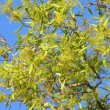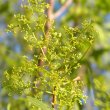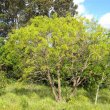Searsia leptodictya
| Botanical Name | Searsia leptodictya |
|||||||||||
| Family | Anacardiaceae - The mango family. |
|||||||||||
| Pronunciation | SEER-zee-a lep-toe-DICK-tee-uh |
|||||||||||
| Common Name(s) |
English: Mountain karee; Rock karee
Afrikaans: Bergkaree; Klipkaree
Sesotho sa Leboa: Mohlwehlwe
siSwati: inHlangushane
|
|||||||||||
| Plant Group |
|
|||||||||||
| Plant Size |
|
|||||||||||
| Position |
|
|||||||||||
| General Information |
|
|||||||||||
| Specific Information | Searsia leptodictya is a small tree or large shrub with an open rounded crown, often multi-stemmed or low-branching. The rough, dark bark and the light green leaves of Searsia leptodictya create an attractive contrast and the foliage brings an extra dimension to the garden. An excellent shade tree in hot regions. The arching branches make it attractive near a water garden and it creates a light shade canopy for more sensitive plants. Useful as a screen against noise, wind and to provide privacy. An essential tree for attracting birds to the garden. The tiny fruits vary in colour from yellow to reddish-brown. |
|||||||||||
| Ad Break | ||||||||||||
| Flowers | ||||||||||||
| Description | minute stars-shaped flowers in loose clusters at the ends of branches |
|||||||||||
| Season |
|
|||||||||||
| Colour |
|
|||||||||||
| Growth Rate |
|
|||||||||||
| Plant Uses |
|
|||||||||||
| Distribution and Habitat | Mpumalanga, Free State, Gauteng, Limpopo and up into Zimbabwe, preferably on rocky hillsides within woodlands, along forest margins and in bushveld |
|||||||||||
| Planting Suggestions | Searsia leptodictya grows in most types of soil. Water well until established. The young plant may need to be pruned into shape for the first few years by removing some of the lower branches. With a bit of care, the Mountain karee will grow about a meter a year The old method of digging a deep hole and filling it with soil and compost has resulted in many trees failing to thrive, dying, rotting at the base or worse still, falling over in later years due to poor root development. Refer to the following sites for the best method of planting trees: International Society of Arboriculture: New Tree Planting Tree People: Plant the right way For those of you who have a clay problem try: |
|||||||||||
| Medicinal Uses | The edible, but sour fruits are used to make beer. |
|||||||||||
| Ad Break | ||||||||||||










Discuss this plant
Share knowledge, ask a question or give an experience.